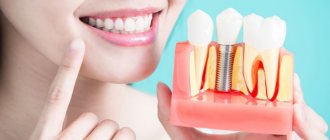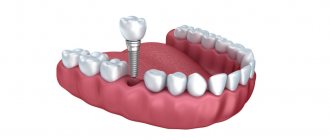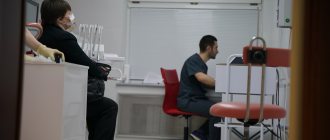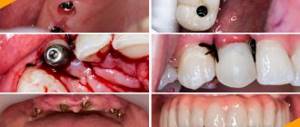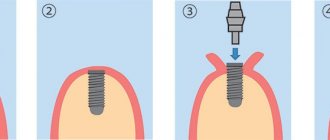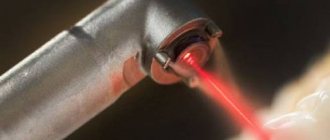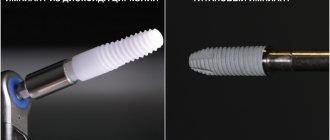Implantation of chewing teeth of the upper and lower jaw at the Elident clinic is carried out by specialists with extensive experience at reasonable prices.
A colossal load falls on the molars and premolars, which are directly involved in chewing food. However, despite their increased strength, teeth in the chewing area are more often than others subject to bacterial attacks and subsequent destruction. If the problem is ignored, a person will inevitably lose lateral units, which is fraught with deterioration in facial aesthetics, changes in bite, disruption of the digestive system and other serious defects.
To avoid undesirable consequences, it is recommended to contact trusted clinics with a good reputation and a high level of trust from patients.
Elident dentistry uses innovative techniques to restore teeth in the chewing area, which guarantees a successful and prolonged result, and also eliminates discomfort during the procedure. At the same time, we use dental systems from premium manufacturers and modern equipment, and also establish impressive discounts on the services provided.
In this article, you will learn about the features of fixing implants in the chewing area, get acquainted with the approximate range of prices in metropolitan clinics and study information regarding the most effective treatment methods.
Is it possible to implant chewing teeth?
Despite the fact that teeth in the chewing area are characterized by increased strength, they are more susceptible to bacteria and the appearance of carious lesions than others. This is due to the active role of molars and premolars in the process of chewing food. Moreover, the loss of lateral units is fraught with a number of problems: impaired functionality, disruptions in the digestive system, deterioration of the maxillofacial apparatus and changes in the anatomical characteristics of the face.
At the moment, the priority method of tooth reproduction is the fixation of dental structures. However, the process of implanting chewing teeth is distinguished by its subtleties, which we will discuss later.
Implantation of chewing teeth: distinctive features
It is important to realize the seriousness of the situation associated with tooth loss in the lateral zone and promptly contact a specialist. First of all, this is due to the likelihood of changes in the position of the dentition and malocclusion with a long-term lack of a molar or premolar. In this case, the process of implanting lateral teeth is significantly complicated. Bone tissue is also subject to loss, which increases the recovery period and significantly increases the cost of surgical intervention.
Implantation of upper chewing teeth
The situation in the maxillary region is complicated by the proximity of the maxillary sinuses to the roots of the chewing teeth. This requires mandatory osteoplasty in this area. As a rule, before implantation of the upper chewing teeth, a procedure is carried out to raise the lower part of the cavity and introduce bone-forming contents into it (sinus lift).
The above manipulation is not particularly labor-intensive, but requires special knowledge and skills from a specialist.
Our clinic employs highly qualified doctors who know all the intricacies of performing osteoplastic operations, and are also ready to perform implantation of chewing teeth at the highest level. This will allow you to eliminate all possible restrictions, avoid unwanted consequences and get long-term results.
Implantation of chewing teeth on the lower jaw
In general, implantation of posterior teeth in the lower jaw is carried out similarly to this procedure in the maxillary region. The difference lies solely in the timing of osseointegration. If the chewing tooth implant is fixed in the lower area, the healing period will be significantly shortened.
It takes approximately 12 weeks for full bone contact with the dental implant.
Implantation sequence
First of all, the patient is examined and a CT scan is made - a computer tomogram of one or both jaws, depending on the extent of the surgical intervention. Sometimes the examination includes additional tests - most often a blood test: general or biochemistry.
The patient has the right to have a tomogram done in another clinic and bring the images to the doctor who will perform the implantation. The average cost of a CT scan is about 3,900 rubles. If no contraindications are found, then begin preparation.
Preparation
Like all-on-4, all-on-6 implantation requires serious consideration and careful planning, especially when there is significant bone loss. The plan is drawn up using computer modeling, during which the most suitable implant parameters are selected. If necessary, surgical templates are made.
The surgical template is a flexible nylon product that has guide holes for implants. It resembles a regular mouthguard used by athletes in potentially dangerous sports.
Thanks to a pre-created template, you can do without an incision and integrate the implants precisely in the direction specified by the program. But this is only necessary in complex clinical situations, when the accuracy of implantation is very important, or the patient does not want incisions and suturing of the gums.
Note: preparatory activities, including 3D modeling and drawing up an implantation plan, take several days.
Implantation
The patient sits on the dental chair, and the operation begins with the extraction of teeth that cannot be restored. The sockets vacated after tooth extraction are treated with an antiseptic solution, and implants are implanted in them or nearby.
Next, sutures are applied, and at the end of the operation, the orthopedic doctor takes impressions of the jaws to make a prosthesis.
The duration of implantation is from 1 to 3 hours.
Prosthetics
A temporary prosthesis is placed a few days after the operation, when the soft tissues have healed. The material for it is usually acrylic with artificial teeth made of metal-plastic. For reliability, a beam structure is used.
You will have to wear a temporary prosthesis from six months to 4 years, after which it will be replaced with a permanent one - metal-ceramic or zirconium.
If you want to get results in 1 day, artificial teeth can be installed just a few hours after the operation. This point is discussed at the examination stage, and then at the first visit the doctor takes impressions. The dentures will be ready by the appointed date.
Attention! Prosthetics immediately after surgery carries risks of complications, so it is undesirable to load the jaws ahead of time, when the soft tissues have not yet healed.
Methods for installing implants in the chewing area
Fixation of dental structures in order to recreate lost lateral teeth is carried out using one of the following methods:
- Traditional method. Characterized by gradual restoration of teeth. At least 16-24 weeks must pass before using the orthopedic system. This time is required for the full engraftment process. In this case, before fixing a permanent prosthesis, the patient uses a removable prosthesis. An important criterion for the procedure is the presence of the required size of bone tissue. If there is a deficiency, osteoplasty is performed in advance;
- One-step procedure. Loading with a temporary system is allowed immediately after implantation of the dental structure. It is possible to fix implants in case of insufficient bone tissue. In this case, the installation is performed in the distant parts of the jaw, which are not prone to loss;
- One-step method. Sold immediately after extraction. Before installing the implant, the hole is treated. Instant fixation of an adaptation-type prosthesis is also allowed. In some cases, after extraction, the dentist uses a classic dental structure, on which the prosthesis is put on after the healing process is completed.
The selection of a technique is influenced by the clinical situation:
- If one unit is lost, the traditional procedure is used, which involves several steps. Initially, it is necessary to wait for complete contact of the bone with the implant, and then fix a permanent type of orthopedic structure onto it. To hide a gap in the dentition, temporary dentures can be used;
- For the loss of several teeth. They resort to a one-stage procedure with immediate fixation of the prosthesis. The adaptation type design prevents the possibility of implants loosening.
What is it like - All-on-6 model
2 implants are placed in the smile area and installed in a straight position. On the sides, where the molars are located, 2 more artificial roots are placed, but at an angle. The entire system can be supplemented with zygomatic implants, if necessary.
Implantation using the All-on-6 method is a design of 6 implants, which is, in fact, a frame for a fixed prosthesis. It can be used for prosthetics of both the upper and lower jaws.
Note: in general, this technology is considered one of the best in terms of price and quality ratio.
Choosing a technique for implanting chewing teeth, taking into account the individual situation
One tooth is missing in the chewing area
If there is a deficiency of one tooth in the lateral zone, and the extraction was performed quite a long time ago and was the result of a serious dental disease, the traditional method is considered the optimal way out of this situation. Moreover, in case of loss of bone tissue, before fixing the dental implant, a procedure for its augmentation is carried out. During the period of osseointegration, the patient is fitted with a removable prosthesis.
Lack of several units in a row on one side
In case of massive tooth loss, a one-stage procedure with immediate loading is used. For this purpose, two or more dental structures are used. If the defect is significant, 4 implants are fixed. Moreover, they are equipped with special adapters for connection with prostheses. To give greater stability to the implants and speed up the period of osseointegration, the adaptation structure is strengthened with a titanium arch.
Missing teeth on both sides
In order to recreate the lateral units that were previously located in opposite parts of the same row, traditional dental systems and instant techniques are used.
However, a necessary step will be to study the condition of the teeth located in the frontal region. If they are destroyed, extraction with immediate fixation of the implants is mandatory. Also, several dental structures are implanted into the chewing area. The prostheses are fixed on them 48-72 hours after the intervention.
Presence of teeth to be removed
If affected teeth are found that need to be removed, the implants are fixed immediately after extraction. In case of emergency removal and in the absence of the possibility of immediate installation of dental systems, you will need to wait about 8-16 weeks until the bone tissue restoration process is completed. Next, the implantation procedure is performed using the traditional method.
How is treatment carried out according to the “all on 6 implants” protocol?
To restore lost teeth, the patient only needs to visit the doctor a few times. At the first visit, the doctor assesses the condition of the dental system and performs a computed tomography scan. The CT scan data is entered into a special program in which it plans the upcoming work: determines the installation locations, depth, and angles of inclination of the pins. The 3D model shows all the anatomical features of the jaws, the location of the sinuses, sinuses, and nerves.
Once the 3D modeling work is completed, surgical templates are printed and temporary prostheses are made. In this case, bite, occlusion and other indicators are taken into account.
Implants are placed through a puncture in the gum and a hole drilled in the bone. The diseased teeth to be removed are first removed from the sockets. Due to the use of templates, even two-piece structures are installed in the right place with high precision. Prosthetics can be done a few hours after the end of the procedure or postponed for 1 or 2 days.
Temporary structures have a metal base that secures all implants, acrylic gums and plastic crowns. It is possible to adapt your own removable denture, but it will not have a rigid frame to stabilize the titanium rods. It is better to install a structure during the engraftment period that will help in this process.
A prosthesis with plastic crowns is used for a maximum of 3 years, and then replaced with a permanent structure. You can immediately choose a model with ceramic composite crowns. Its service life is at least 5 years.
Our clinics
Clinic "Elident" on Varshavskaya
Varshavskoe highway, 75, bldg. 1, Moscow 117556
- Varshavskaya (500 m, closed until 2021)
- Nakhimovsky Prospekt (1,300 m)
Mon-Sat : 09:00-21:00; Sun : 09:00-19:00.
Online registration
+7 (495) 649-41-19
Elident Clinic in Annino
Varshavskoe highway, 154, building 1, Moscow 117405
- Annino (500 m)
- Academician Yangelya (700 m)
Mon-Sat : 09:00-21:00; Sun : 09:00-19:00.
Online registration
+7 (495) 649-41-19
Which implants are best placed on chewing teeth?
To replace teeth of each type, dentists use a specific prosthetic technique and a specific implantation system, which allows them to obtain the necessary aesthetic and functional characteristics.
If we talk about which implant is best placed on chewing teeth , then it is quite obvious that shortened and excessively thin dental structures are not used in this department. To select the optimal implant size for a chewing tooth , the parameters of the interdental spaces and the anatomical characteristics of the jaw are taken into account.
Regarding the restoration method used, traditional methods are usually used to reconstruct teeth in the lateral area. It involves the step-by-step implementation of procedures for implantation and fixation of the orthopedic structure. This is due to the need to undergo a period of engraftment and increased chewing pressure in the future. During the period of osseointegration, the patient wears a temporary orthopedic structure.
Almost all modern manufacturers have models of implants for restoring teeth in the lateral area. Which system to choose depends on your budgetary capabilities, clinical situation and recommendations of the attending physician.
At the Elident clinic you can install a chewing tooth implant at an affordable price .
We cooperate directly with manufacturers of premium implantation systems, regularly hold promotions and provide a guarantee of long-term results.
One stage surgery
All-on-6 technology is a kind of continuation of “all-on-4”, its more advanced version. It eliminates the shortcomings of the “all-on-4” implantation protocol.
The main difference of the All-on-6 protocol is the addition of 2 additional implants, which are integrated in the area of the chewing teeth, 1 on each side. According to this protocol, the implantation scheme looks like this:
- In the area of the front teeth, 2 implant pins are installed in a vertical plane.
- 2 roots are implanted on the sides of the jaw: the first pair is also placed vertically, and the installation of the second (more distant) may require installation at an angle.
- For lateral implants, special multi-unit abutments are used, which means “multi-block”. These are multi-component parts, consisting of several elements, but their main feature is screw fixation. Thanks to multiblock abutments, the tooth crown can be placed strictly vertically, regardless of the angle of inclination of the implant.
It is worth noting that when using this technology, the load is distributed evenly. Therefore, the system operates in optimal mode and is not overloaded, and the likelihood of implant rejection is minimized.
Moreover, the prosthesis can be installed 3 days after surgery, which allows All-on-6, like All-on-4, to be classified as a one-stage implantation protocol with immediate loading.
Stages of installing implants on chewing teeth
Diagnostics
At this step, a visual examination of the oral cavity is carried out, and diagnostics are also performed using modern scanners, which allow a detailed study of the condition of the patient’s jaw. A mandatory point is to conduct laboratory examinations, which eliminates any restrictions for implantation of chewing teeth in the upper jaw or in the mandibular region.
Preparatory procedures
Before surgical intervention, the specialist carries out therapeutic measures aimed at eliminating carious lesions and removing hard deposits on the surface of the teeth.
Implant fixation
To numb the site of future intervention, local anesthetics are used. As part of the traditional procedure, the dental implant is fixed in a straight position; when implementing a one-stage technique, an inclined installation of the structure is allowed. In the case of a two-stage concept, a special plug is used and the gums are sutured. When using a one-piece implant, the adapter is already included in the design and is located above the line of gingival tissue.
Abutment installation
Fixation of the connecting element is carried out exclusively after osseointegration of the classical type implant (after 16-24 weeks). 14 days before this moment, the structure is installed to create the correct gingival contour.
Fixing the crown on the implant
Taking into account the technique used, the installation of the orthopedic structure is carried out immediately or after completion of the engraftment stage. In the case of one-stage technology, fixation of prostheses is allowed 48 hours after surgery. In the traditional procedure, only after the end of the osseointegration period.
Features of restoration of teeth in the upper jaw
- The maxillary bone is less dense than the lower bone and therefore undergoes atrophy more quickly. If teeth have been missing for a long time, the patient may need bone augmentation (sinus lift surgery) before implantation.
- When using the classical technique, the engraftment period is 3-4 months.
- For single restorations, a one-stage protocol with immediate crown fixation is allowed due to lower chewing loads.
- When implanting in the upper jaw, the doctor requires “jeweller” precision. The accessory nasal sinuses and large nerves pass near the implantation zone.
- It is possible to use elongated (zygomatic) implants.
Advantages and disadvantages of dental implantation
| Advantages | Negative points |
| Increased reliability | The need to perform osteoplastic procedures – with the traditional technique |
| Natural appearance of the dentition | Significant trauma |
| Possibility of preventing bone loss | When implementing the traditional concept, the recovery period can stretch up to 12 months |
| Long service life | Increased risk of negative consequences, difficult rehabilitation period |
| Not carried out if there are restrictions |
Bridge or implant on a chewing tooth: which is preferable?
In the case of multiple deficiencies of teeth in a row, the patient is faced with a difficult question: “ I fix a bridge or an implant on the chewing tooth ?” Clearly, the priority choice is fixation of the dental structure followed by installation of the transition element and prosthesis. But this is not always possible, since implantation of chewing teeth is overpriced - with insufficient bone tissue. The best option in such a situation would be to fix a bridge structure, the supporting elements of which are the patient’s natural teeth. A significant disadvantage of this procedure is the need for pulp removal and preparation, which causes further destruction of the teeth.
Implantation in the complete absence of the upper dentition (edentia)
Adentia provokes a large number of complexes and disrupts the proportions of the face. Previously, only removable dentures were used in this case, but at the moment the integrity of the dentition can be restored using prosthetics on implants.
Implantation methods for edentulous patients:
- Full. In this case, an implant is implanted in place of each missing tooth unit, on which a crown is fixed. This method is not suitable for everyone, as it requires a large amount of bone tissue. Also, a serious obstacle to this operation can be nerves located close to the implant sites.
- Technique using bridges. The structure is supported by artificial teeth. The number of products varies from 6 to 8. A fixed bridge implant is universal and suitable for almost everyone.
- All-on-4 method. A relatively new technique, relevant for patients with bone deficiency. It consists of installing 4 implants on which a fixed prosthesis is installed. Side products are implanted at an angle of 35-60 degrees. If it is necessary to get rid of the remaining dental units, implants are implanted simultaneously with their removal, near the holes or directly into them.
- Prosthetics with a minimum of implants. In some cases, it is impossible to implant even 4 units, then the implantation of the upper jaw is done with 2 or 3. For this purpose, abutments with a spherical tip are used, ensuring reliable fastening of the prostheses.
- Removable prosthetics on mini-implants. This technique of implanting upper teeth is used when there is a deficiency of bone tissue that cannot be replenished for a number of reasons.
When choosing the optimal method for edentia, you should definitely consult with a specialist and undergo all the studies he suggests. In this case, when implanting the upper teeth, the least traumatic method for the patient will be used.
Prices for implantation of chewing teeth at the Elident clinic
| Service | Price, ₽. |
| Consultation with an orthopedist | for free |
| Orthopantomogram - panoramic image of teeth | 950 |
| Dental implantation - Anesthesia + Implant + Implant installation + Cover screw + Suture placement and removal + Postoperative examination | |
| Installation of Osstem implant (Korea) | 27 000 |
| Installation of BioLine implant (Germany) | 27 000 25 000 |
| Installation of the Alpha Bio implant (Israel) | 27 000 25 000 |
| Installation of Straumann implant (Switzerland) Promotion!!! | 45 000 34 900 |
| Turnkey dental implantation – Anesthesia + Implant + Implant installation + Cover screw + Healing abutment installation + Impressions + Abutment installation + Crown installation | |
| Metal-ceramic crown | |
| Installation of Osstem implant (Korea) + metal-ceramic crown | 55 100 |
| Installation of BioLine implant (Germany) + metal-ceramic crown | 55 100 53 100 |
| Installation of Alpha Bio implant (Israel) + metal-ceramic crown | 55 100 53 100 |
| Installation of Straumann implant (Switzerland) Promotion!!! + metal-ceramic crown | 76 000 66 000 |
| Zirconium dioxide ceramic crowns | |
| Installation of Osstem implant (Korea) + zirconium dioxide crown | 61 600 |
| Installation of BioLine implant (Germany) + zirconium dioxide crown | 61 600 59 600 |
| Installation of Alpha Bio implant (Israel) + zirconium dioxide crown | 61 600 59 600 |
| Installation of Straumann implant (Switzerland) Promotion!!! + zirconium dioxide crown | 84 000 74 000 |
| Sinus lift (bone grafting) | |
| Sinus lift I | 15 000 |
| Sinus lift II | 25 000 — 40 000 |
The total costs associated with fixing implants in the chewing area include the cost of the dental system itself, the orthopedic structure and the work of a specialist. In the absence of sufficient bone size, the cost will increase significantly. Approximate prices for the procedure in metropolitan clinics range from 30 to 60 thousand rubles. If you want to choose a more budget-friendly treatment option, you should focus on systems such as Osstem, Alpha Bio, BioLine, etc.
The Elident clinic has set loyal prices for premium segment implants. Thus, you can fix the top Swiss Strauman systems at a cost of 66 thousand rubles. The price is indicated on a turnkey basis: taking into account the fixation of the adapter, devices for creating the correct gingival contour and the orthopedic design.
Learn more about prices for dental implants >
Price issue
The cost of All-on-6 implantation consists of several components:
- type and number of examination procedures;
- volume of preparation - the number of teeth that need to be removed, the models of implants chosen by the surgeon;
- the need to create a template;
- system brand - premium Nobel Biocare pins or more budget options Osstem and Alpha Bio can be used;
- type of fixed prosthesis.
With complete loss of teeth, the possibilities of implantation are limited, since due to atrophy of the jaw bone it is impossible to implant artificial roots. A person is faced with a choice - to wear uncomfortable and unsightly removable dentures, undergo a complex and expensive osteoplasty operation, or opt for the advanced all-on-4 and all-on-6 methods.
Reviews about implantation of chewing teeth
Regardless of whether the implantation of the upper chewing teeth , or a similar procedure on the lower jaw, reviews of the treatment results always remain positive, which is due to the 100% success of the technique.
Negative opinions are usually due to the low competence of specialists and an improperly performed procedure.
If we talk about specific brands designed to restore the chewing area, Strauman, Nobel and Astra Tech confidently hold the leading positions. In general, the traditional procedure is permitted only in the absence of any restrictions.
An alternative to implants in dentistry for chewing teeth
Other alternative techniques may also be used, including:
- Application of a bridge structure. In this case, the role of supports is played by the patient’s natural teeth, located on the sides of the prosthesis. However, fixation of the bridge is allowed only after preparation of the supporting units and removal of the pulp, which is one of the significant “disadvantages” of the procedure. Another negative point is the lack of sufficient load, which causes bone tissue atrophy. This design is used to replace 3-4 teeth located in a row;
- Use of a removable prosthesis. Depending on the extent of the defect, the appropriate method of tooth restoration and material are selected. If only a few units are missing, special hooks are used as fastening. In the case of an absolute lack of teeth, a suction effect is realized. The “disadvantages” include: the need for regular removal of the structure, deterioration of the speech apparatus, further resorption of bone tissue and the appearance of serious aesthetic problems.
Article expert (author):
